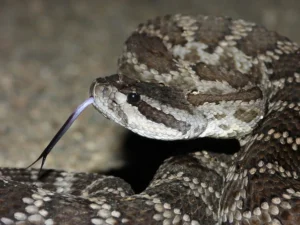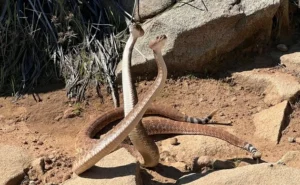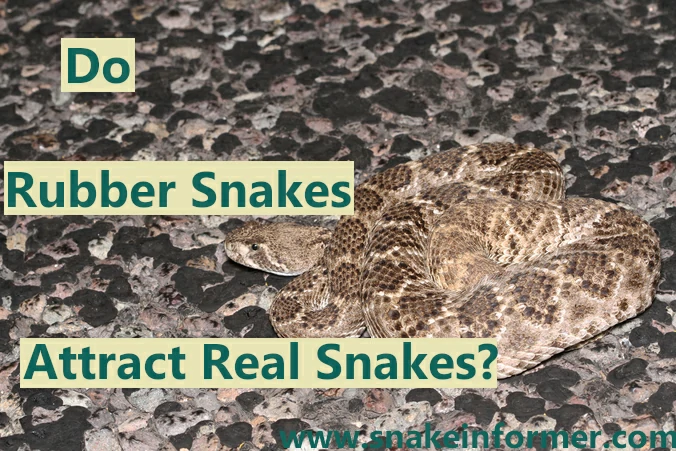Gardeners and homeowners sometimes use rubber snakes to deter, birds and other small animals such as mice and squirrels. But do these props attract real snakes?
Rubber snakes do not attract real snakes. They do not have a scent, body heat, movement, or chemical cues that can be picked up by snakes. Their presence, or absence has no influence on snakes at all.
Snakes in general are attracted by scent, temperature, and movement rather than visual appearance.
Even if a snake saw a rubber snake, and somehow thought it was a real snake, its instinct would likely be to leave. It would not go to the area and investigate.
Rubber Snakes Don’t Attract Real Snakes
Snakes don’t see the world in the same way we do. While they have eyes, they are mainly guided by smell, heat, and movement.
To smell, snakes flick their tongues through the air.
The tongue then picks up molecules, and these molecules reach a part of the roof of their mouth called the Jacobson’s organ.
This organ helps decode the molecules into different smells, helping them locate prey, mates, or potential danger.

In addition, many snake species (such as pit vipers) have heat-sensing pits. These pits allow them to detect the body heat of warm-blooded animals, giving them a thermal image of nearby creatures.
This is crucial when snakes hunt and navigate their surroundings in darkness, or dense vegetation.
Movement is another key factor. Snakes are very sensitive to vibrations and motion.
A mouse moving in tall grass will catch their attention faster, than an object that’s in the open, but not moving.
3 Reasons Why Rubber Snakes Don’t Attract Real Snakes
Rubber snakes do not move, emit any organic scent, or produce any body heat. As a result, they do not register as living features to any snakes.
1. Rubber Snakes Do Not Move
Rubber snakes do not move, so they fail to mimic the natural behavior of a real snake.
Movement is a key indication of life, and snakes use it to detect prey and assess their environments.
A real snake might thrash, coil, or show other deliberate movement. These visual cues can draw the attention of other snakes.
However, a rubber snake that is completely still gives off none of the behavioral signals associated with a living snake.
Due to this lack of movement, rubber snakes are overlooked by real snakes.
2. Rubber Snakes Do Not Have Any Organic Scent
Snakes heavily rely on chemical signals to navigate their environments.
Rubber snakes do not have any organic scent that real snakes would associate with food or other snakes.
For this reason, they don’t trigger the same behavioral response that an organic scent would.
Unless a rubber snake is rubbed with the scent of prey (for example, rodents or fish), or the pheromones of a real snake – it will be virtually invisible to a passing snake.
3. Rubber Snakes Do Not Have Any Body Heat
Rubber snakes emit no body heat, and do not have any infrared signature.
To heat-sensing snakes, rubber snakes are no different from rocks or sticks.
They are thermally invisible and do not resemble any living creatures at all.
Even if a rubber snake looked realistic, the lack of body heat would confirm to real snakes, that it’s just a lifeless object.
If You Think Your Rubber Snake Attracted a Real One, It’s Just a Coincidence
Some people place rubber snakes in their yard or garden, and then see real snakes in the same area.
However, these two events are unrelated.
Snakes gravitate to areas where they can hide, find food, and stay warm/cool. They are not attracted by artificial objects.
Here are a few real reasons why snakes may be attracted to your yard or garden:
- Abundance of Prey
One of the most common reasons snakes are attracted to an area is the presence of prey animals, such as rodents, birds, frogs, and insects.
If your yard or garden has a rodent problem, or attracts other small animals, it becomes a magnet for hungry snakes looking for a meal.
- Shelter and Hiding Spots
Tall grass, wood piles, or abandoned burrows create ideal locations for snakes to hide or ambush prey.
Having these in your yard or garden can attract snakes seeking shelter.
- Water Sources
Snakes need water just like any other animal.
A dripping hose, birdbath, pond, or even a moist patch of soil can attract them, especially in dry weather.
- Warmth
Like all reptiles, snakes are cold-blooded (ectothermic) animals.
This means they cannot internally regulate their body temperature. Instead, their body temperature changes with the temperature in their surroundings.
In the wild, snakes bask on sun-heated rocks or hide in underground burrows to escape low temperatures.
If your yard or garden has sunny spots or warm compost piles, it can be attractive to snakes.
Would a Real Snake Respond to the Sight of Another Real Snake?
Snakes don’t primarily rely on visual recognition when interacting with other snakes. Instead, they rely on pheromones.
For example, during mating season, males follow scent trails left by females. They don’t recognize mates by sight but by their scent.

Even if a snake saw a rubber snake, it would have no reason to investigate.
Generally, snakes are solitary animals and don’t seek out other snakes, except during the mating season.
Conclusion
Rubber snakes don’t, smell, or produce any body heat.
To real snakes, they are no different from rocks, sticks, or other pieces of plastic.
They do not attract, or trigger any real interest.
If you are worried about snakes being attracted to your yard, ignore the rubber snakes, and instead focus on the environmental factors that can really draw in snakes.
Sources:
Joseph Caspermeyer, Snake Eyes: New Insights into Visual Adaptations, Molecular Biology and Evolution, Volume 33, Issue 10, October 2016, Page 2765, https://doi.org/10.1093/molbev/msw183
Snake Bioacoustics: Toward a Richer Understanding of the Behavioral Ecology of SnakesBruce A. YoungThe Quarterly Review of Biology 2003 78:3, 303-325
Schraft, H.A., Bakken, G.S. & Clark, R.W. Infrared-sensing snakes select ambush orientation based on thermal backgrounds. Sci Rep 9, 3950 (2019). https://doi.org/10.1038/s41598-019-40466-0
Hi, my name is Ezra Mushala, i have been interested animals all my life. I am the main author and editor here at snakeinformer.com.

